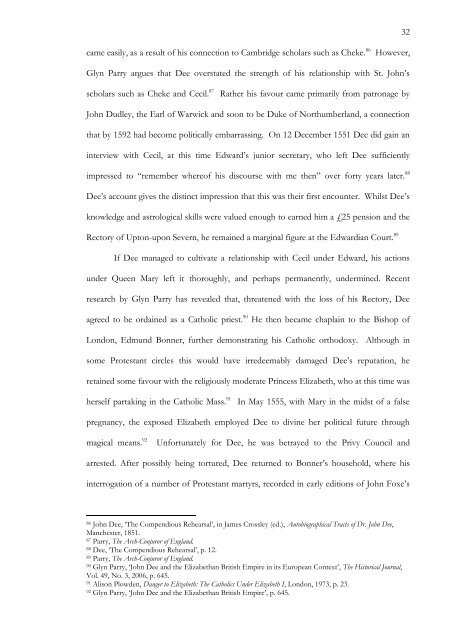The Alchemical Patronage of Sir William Cecil, Lord Burghley
The Alchemical Patronage of Sir William Cecil, Lord Burghley
The Alchemical Patronage of Sir William Cecil, Lord Burghley
Create successful ePaper yourself
Turn your PDF publications into a flip-book with our unique Google optimized e-Paper software.
came easily, as a result <strong>of</strong> his connection to Cambridge scholars such as Cheke. 86 However,<br />
Glyn Parry argues that Dee overstated the strength <strong>of</strong> his relationship with St. John‘s<br />
scholars such as Cheke and <strong>Cecil</strong>. 87 Rather his favour came primarily from patronage by<br />
John Dudley, the Earl <strong>of</strong> Warwick and soon to be Duke <strong>of</strong> Northumberland, a connection<br />
that by 1592 had become politically embarrassing. On 12 December 1551 Dee did gain an<br />
interview with <strong>Cecil</strong>, at this time Edward‘s junior secretary, who left Dee sufficiently<br />
impressed to ―remember where<strong>of</strong> his discourse with me then‖ over forty years later. 88<br />
Dee‘s account gives the distinct impression that this was their first encounter. Whilst Dee‘s<br />
knowledge and astrological skills were valued enough to earned him a £25 pension and the<br />
Rectory <strong>of</strong> Upton-upon Severn, he remained a marginal figure at the Edwardian Court. 89<br />
If Dee managed to cultivate a relationship with <strong>Cecil</strong> under Edward, his actions<br />
under Queen Mary left it thoroughly, and perhaps permanently, undermined. Recent<br />
research by Glyn Parry has revealed that, threatened with the loss <strong>of</strong> his Rectory, Dee<br />
agreed to be ordained as a Catholic priest. 90 He then became chaplain to the Bishop <strong>of</strong><br />
London, Edmund Bonner, further demonstrating his Catholic orthodoxy. Although in<br />
some Protestant circles this would have irredeemably damaged Dee‘s reputation, he<br />
retained some favour with the religiously moderate Princess Elizabeth, who at this time was<br />
herself partaking in the Catholic Mass. 91 In May 1555, with Mary in the midst <strong>of</strong> a false<br />
pregnancy, the exposed Elizabeth employed Dee to divine her political future through<br />
magical means. 92 Unfortunately for Dee, he was betrayed to the Privy Council and<br />
arrested. After possibly being tortured, Dee returned to Bonner‘s household, where his<br />
interrogation <strong>of</strong> a number <strong>of</strong> Protestant martyrs, recorded in early editions <strong>of</strong> John Foxe‘s<br />
86 John Dee, ‗<strong>The</strong> Compendious Rehearsal‘, in James Crossley (ed.), Autobiographical Tracts <strong>of</strong> Dr. John Dee,<br />
Manchester, 1851.<br />
87 Parry, <strong>The</strong> Arch-Conjuror <strong>of</strong> England.<br />
88 Dee, ‗<strong>The</strong> Compendious Rehearsal‘, p. 12.<br />
89 Parry, <strong>The</strong> Arch-Conjuror <strong>of</strong> England.<br />
90 Glyn Parry, ‗John Dee and the Elizabethan British Empire in its European Context‘, <strong>The</strong> Historical Journal,<br />
Vol. 49, No. 3, 2006, p. 645.<br />
91 Alison Plowden, Danger to Elizabeth: <strong>The</strong> Catholics Under Elizabeth I, London, 1973, p. 23.<br />
92 Glyn Parry, ‗John Dee and the Elizabethan British Empire‘, p. 645.<br />
32















